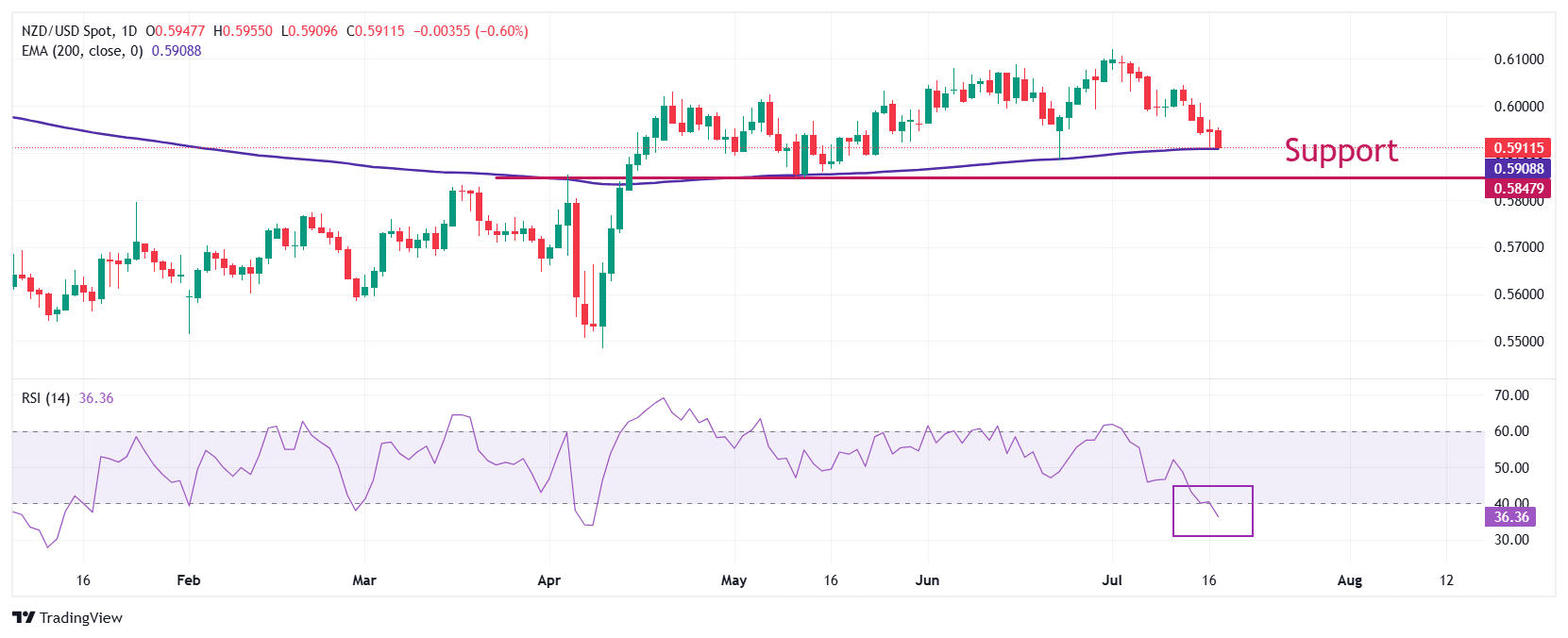NZD/USD Price Forecast: Struggles to hold 200-day EMA
- NZD/USD tumbles to near 0.5900 as the US Dollar trades firmly.
- US President Trump denied reports stating that he will fire Fed’s Powell soon.
- The pair struggles to stay above the 200-day EMA, which trades around 0.5910.
The NZD/USD pair trades 0.6% lower to near the round-level of 0.5900 during European trading hours on Thursday. The Kiwi pair weakens as the US Dollar (USD) strengthens, following comments from United States (US) President Donald Trump that he will not fire Federal Reserve (Fed) Chairman Jerome Powell.
The US Dollar Index (DXY), which tracks the Greenback’s value against six major currencies, trades firmly to an over three-week high around 99.00.
On Wednesday, US President Trump refuted claims that he will fire Fed’s Powell soon, citing that the action could upheaval markets. "I’d love if he wants to resign, that would be up to him. They say it would disrupt the market if I did," Trump said in an interview with Real America’s Voice network.
Meanwhile, traders have pared Fed dovish bets as the latest Consumer Price Index (CPI) report for June has shown that prices of products that are largely imported by the US have increased.
NZD/USD slides to near the 200-day Exponential Moving Average (EMA), which is around 0.5910, suggesting that the overall trend has become uncertain.
The 14-day Relative Strength Index (RSI) slides below the 40.00 level, suggesting that a downside momentum has been triggered.
Going forward, a downside move by the pair below the June 23 low of 0.5883 will expose it to the May 12 low of 0.5846, followed by the round-level support of 0.5800.
In an alternate scenario, the Kiwi pair would rise towards the June 19 high of 0.6040 and the September 11 low of 0.6100 if it manages to return above the psychological level of 0.6000.
NZD/USD daily chart

US Dollar FAQs
The US Dollar (USD) is the official currency of the United States of America, and the ‘de facto’ currency of a significant number of other countries where it is found in circulation alongside local notes. It is the most heavily traded currency in the world, accounting for over 88% of all global foreign exchange turnover, or an average of $6.6 trillion in transactions per day, according to data from 2022. Following the second world war, the USD took over from the British Pound as the world’s reserve currency. For most of its history, the US Dollar was backed by Gold, until the Bretton Woods Agreement in 1971 when the Gold Standard went away.
The most important single factor impacting on the value of the US Dollar is monetary policy, which is shaped by the Federal Reserve (Fed). The Fed has two mandates: to achieve price stability (control inflation) and foster full employment. Its primary tool to achieve these two goals is by adjusting interest rates. When prices are rising too quickly and inflation is above the Fed’s 2% target, the Fed will raise rates, which helps the USD value. When inflation falls below 2% or the Unemployment Rate is too high, the Fed may lower interest rates, which weighs on the Greenback.
In extreme situations, the Federal Reserve can also print more Dollars and enact quantitative easing (QE). QE is the process by which the Fed substantially increases the flow of credit in a stuck financial system. It is a non-standard policy measure used when credit has dried up because banks will not lend to each other (out of the fear of counterparty default). It is a last resort when simply lowering interest rates is unlikely to achieve the necessary result. It was the Fed’s weapon of choice to combat the credit crunch that occurred during the Great Financial Crisis in 2008. It involves the Fed printing more Dollars and using them to buy US government bonds predominantly from financial institutions. QE usually leads to a weaker US Dollar.
Quantitative tightening (QT) is the reverse process whereby the Federal Reserve stops buying bonds from financial institutions and does not reinvest the principal from the bonds it holds maturing in new purchases. It is usually positive for the US Dollar.

